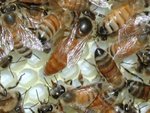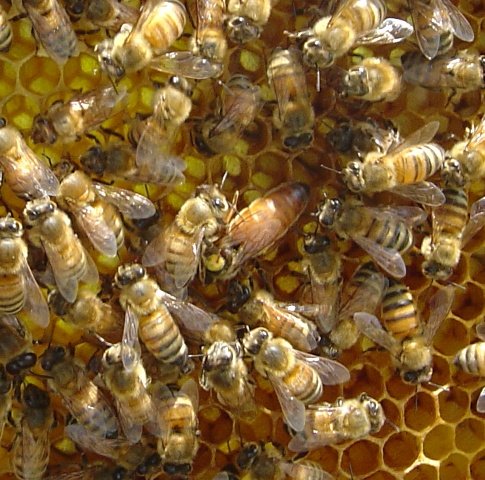Above: Worker bee collecting pollen in my garden
The weather was damp and humid, not the best conditions for opening up a hive.
Bees make great barometers you know. It can be a clear, warm, sunny day, (perfect weather for opening a hive), but if rain is coming in the late evening, the bees will let you know by their attitude.
Right: As I clean out the shed of old bee packages, old comb, and old frames, my debris pile slowly grows.
If you are going to keep bees on Cape Cod you will have to get use to working with them in all types of weather. One minute it will be clear, then, in a minute the weather will change. I don’t know how many times I have started the smoker with blue sunny skies, only to have dark cloudy weather by the time I pull out my first frame of bees.
Left: Another worker collecting nectar and pollen
Saturday, between the rain, the bees were flying, obviously collecting nectar an pollen from something that is in bloom.
Above: A solid brood pattern layed by one of the queens I raised last season.
I opened up the hives to find that the bees were storing honey in the honey supers.
I made a choice this season to not use queen excluders when supering for honey. A queen excluder is a grid of wire that when placed between boxes of comb prohibits the queen from passing between the boxes. The spacing in the grid allows worker bees to move through, but not the queen.
Left: An over productive queen was not able to resist the temptation to lay eggs in my honey super. Look closely and you will see the small egg at the bottom of the cell. Click on the photo to enlarge.
In past years I felt that the queen excluders discouraged the worker bees from moving up into the honey supers, acting as more of a honey excluder than anything else.
Of course you also take the chance that the queen will move up into the honey supers and lay eggs. Not something you want to see, that is, eggs mixed on a comb with your honey.
Right: Opening up the hive to find ripe honey being capped over is what a beekeeper loves to see.
I have one hive that has a queen that is laying so many eggs that she has run out of room in the brood chamber. Sure enough when I inspected the honey super, there she was sitting on six frames of eggs where honey was to be. I took her and placed her in a lower box, then added a queen excluder. In about a month those eggs will hatch out into worker bees and the bees can store honey in the empty comb.
It is nice to see the bees storing honey in comb that I will take as my own in a couple of months. Honey comb is beautiful. The bees collect nectar from the plants and store it in their honey stomachs. Once back in the hive they place the nectar in the comb.
Nectar from flowers contains about 1% sugar. The bees evaporate the water and concentrate the sugar to turn it into honey. Once the honey is “ripe” they cap over the cell with wonderful white wax. The wax seals the honey and keeps it from absorbing moisture from the air.
It is estimated that it takes about 10,000 miles of flying to make a table spoon of honey.
It is exciting to see.
Nectar from flowers contains about 1% sugar. The bees evaporate the water and concentrate the sugar to turn it into honey. Once the honey is “ripe” they cap over the cell with wonderful white wax. The wax seals the honey and keeps it from absorbing moisture from the air.
It is estimated that it takes about 10,000 miles of flying to make a table spoon of honey.
It is exciting to see.
Above: Ripe honey being capped by the workers. You can see the white capping wax.
In a couple of months we will taste that honey.
What honey tastes the best to me?















No comments:
Post a Comment